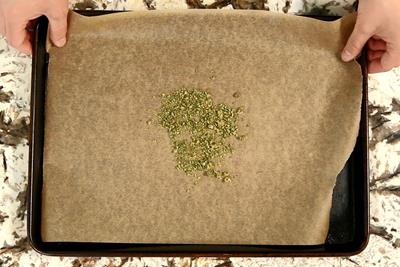
Sunday November 4, 2018
 Education
Education
Homemade edibles and tinctures are a great way to get the long-term therapeutic benefit of cannabis without causing irritation to the airways. But for cannabis edibles to have the biggest impact, simply throwing a handful of ground weed into a batch of brownies won’t suffice. If you want to feel the full effects from your homemade cannabis products, you’ll need to decarboxylate, or decarb, your flower first.
What Does it Mean to Decarboxylate Cannabis
Decarboxylation is the process of removing a carboxyl atom from a chemical structure. When it comes to cannabis, decarboxylation refers to the removal of the carboxylic acid, COOH, which turns the non-psychoactive, THCA (tetrahydrocannabinolic acid) into the psychoactive cannabinoid, THC (tetrahydrocannabinol). The process happens naturally over time, especially when exposed to light and air, but can be expedited by placing cured cannabis in the oven prior to cooking with it or infusing it into an oil or alcohol.

It’s important to decarb your cannabis before you bake with it to bring out your weed’s psychoactive qualities. Though some cannabinoids will decarb during the baking process, toasting your cannabis beforehand will ensure that all THCA gets converted to THC for optimal results.
How to Decarb Cannabis
Decarbing cannabis is super easy and oh-so worth it. All you need is some ground bud (check out some local dispensaries for deals on shake), a baking sheet, foil or parchment paper and an oven. Begin by preheating your oven to about 240 degrees (you can go as low as 225 if you want to preserve terpenes but you’ll have to toast it longer if you do) and line a baking sheet with parchment paper or foil.
Spread ground cannabis evenly on the baking sheet then pop it in your preheated oven for about an hour. Your home might smell a lot like weed, though, so you may want to burn some candles or sauté up some onions if nosey neighbors are a concern. Check out this article for more tips on hiding the smell of weed in your home.
Using Your Decarboxylated Cannabis
Once you’ve decarboxylated your cannabis, the fun really begins! Decarbed cannabis can be used in many recipes by infusing it into oils (like butter or coconut oil) or alcohol. Note that cannabinoids are not water soluble (they will not absorb into water), so they must be infused into either a lipid or alcohol if they are to be absorbed into the bloodstream.
Deciding what to infuse your decarbed cannabis into largely depends on how you intend to use it. Alcohol-infused tinctures are ideal for use in liquids or for sublingual absorption whereas oils may be better for baked goods.
Coconut oil is one of the best lipids for cannabis infusion because it retains more cannabinoids than other oils and has a relatively high burning point compared to olive, corn or hemp seed oils. Coconut oil also contains medium chain triglycerides to help the absorption process and acts as an antioxidant within the body.
There’s no need to spend top dollar on cannabis edibles from a dispensary. Potent pot products can be made right at home by first decarboxylating cannabis then infusing it into butter, oil or alcohol!
Do you have any tips for decarbing cannabis at home? Share them with our readers in the comments section below.







